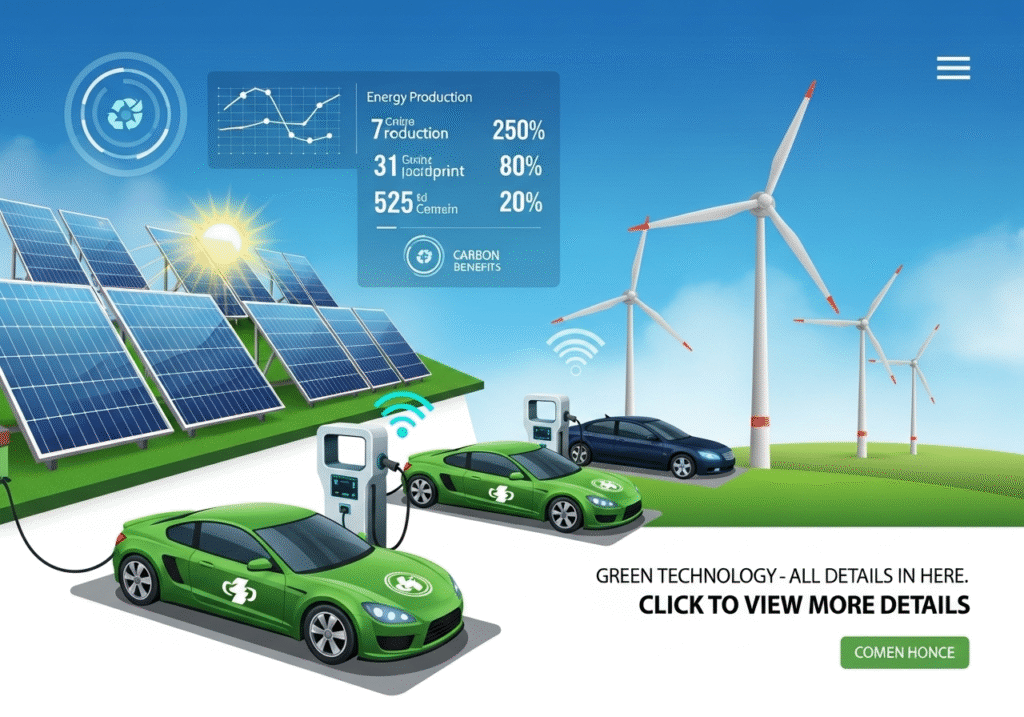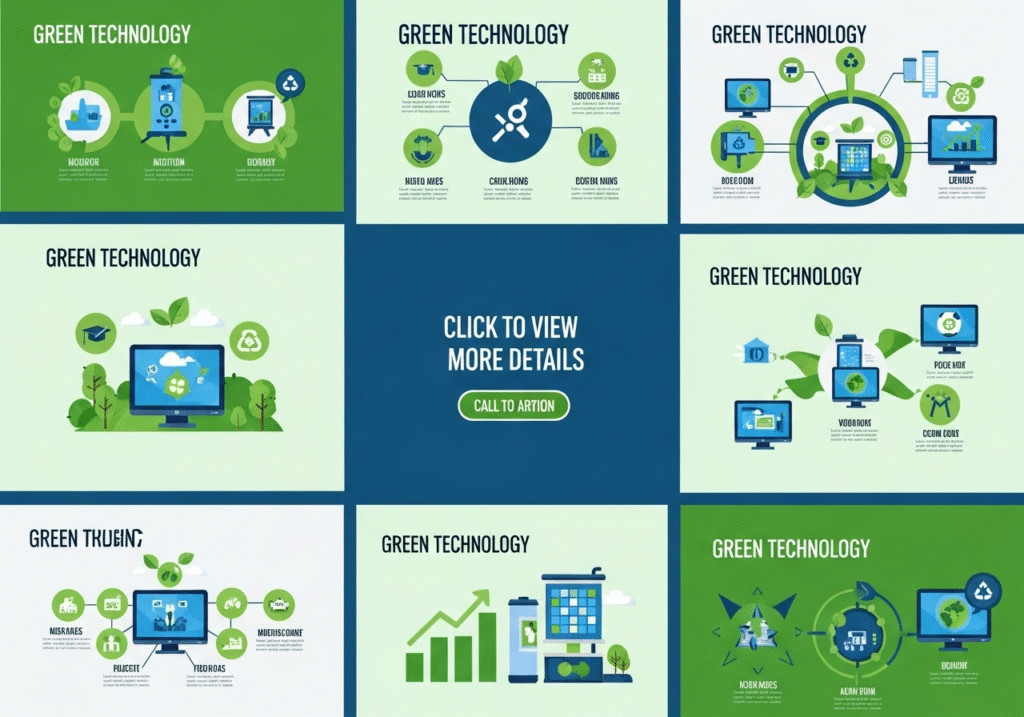
Explore how green technology is transforming our planet. Learn about innovations, benefits, challenges, and how tech giants like Google, Apple, and Microsoft are uniting for a sustainable future.
🌍 1. Introduction: Tech Giants Unite for Sustainability

In 2025, the urgency to address climate change has reached new heights. Major tech companies—including Google, Apple, Microsoft, Amazon, and Meta—have announced a joint global initiative aimed at accelerating green technology adoption. From renewable energy to eco-friendly data centers, these companies are setting aggressive goals to reach net-zero carbon emissions by 2030.
This global movement isn’t just corporate branding—it’s reshaping how energy, technology, and innovation intersect in what is now the Green Tech Era.
🌱 2. What Is Green Technology?
Green technology (also known as clean tech or sustainable technology) refers to:
“The development and application of products, equipment, and systems that conserve the natural environment and resources.”
It includes:
- Renewable energy (solar, wind, hydro)
- Energy efficiency
- Waste management
- Electric vehicles
- Green building materials
- Sustainable agriculture technologies
The core objective is to minimize environmental impact while maximizing productivity and innovation.
⚡ 3. Why Green Technology Matters Today

Key Reasons:
- 🌡️ Climate change mitigation
- 🏭 Reduction in industrial pollution
- 🔋 Energy independence
- 🌾 Sustainable food production
- 🏘️ Eco-friendly urban development
Green technology isn’t optional—it’s the foundation of a livable future.
🔧 4. Key Areas of Green Tech Innovation
🔋 1. Renewable Energy
- Solar panels (Tesla, SunPower)
- Wind farms (Siemens Gamesa)
- Hydropower innovations
🏘️ 2. Green Buildings
- Smart thermostats
- LEED-certified materials
- Vertical gardens
♻️ 3. Waste Reduction
- Smart recycling robots
- Circular economy platforms
- Biodegradable plastics
🚗 4. Electric Vehicles (EVs)
- Tesla, Rivian, Lucid
- Battery innovations and EV charging infrastructure
🌿 5. Carbon Capture & Storage (CCS)
- Microsoft’s carbon-negative commitment
- Climeworks direct air capture
🏢 5. Green Technology in Action: Company Case Studies

- Carbon-free energy by 2030
- AI for energy-efficient cooling in data centers
✅ Apple
- Recyclable aluminum in MacBooks
- Zero-waste packaging and closed-loop supply chain
✅ Microsoft
- Pledged to be carbon negative by 2030
- $1B Climate Innovation Fund
✅ Amazon
- Co-founded the Climate Pledge
- 100,000 electric delivery vans by 2030
🌎 6. Environmental Benefits of Green Technology

- 🔽 Reduction in greenhouse gas emissions
- 💧 Water conservation
- 🌾 Reduced land degradation
- 🦋 Protection of biodiversity
- 🌬️ Cleaner air and public health improvements
🚧 7. Challenges Facing the Green Tech Revolution
Despite its potential, green tech faces several hurdles:
| Challenge | Description |
|---|---|
| 💸 High Costs | Upfront investment remains high |
| 🔌 Infrastructure Gaps | Especially in rural or developing areas |
| 📉 Slow Policy Adoption | Government regulations lag behind |
| 🧪 Technological Limitations | Battery storage, recycling, etc. |
🧠 8. Tech Giants Leading the Way
| Company | Sustainability Goal | Notable Initiative |
|---|---|---|
| Carbon-free energy by 2030 | AI-optimized energy | |
| Apple | 100% recycled materials | Closed-loop supply chain |
| Microsoft | Carbon negative by 2030 | Carbon Capture |
| Amazon | Net-zero by 2040 | The Climate Pledge |
| Meta | Net-zero across supply chain | Renewable data centers |
🌐 9. Government and Global Policies Supporting Green Tech
🌍 International Agreements:
- Paris Agreement
- UN Sustainable Development Goals
🌐 National Initiatives:
- 🇺🇸 U.S. Green New Deal investments
- 🇬🇧 UK’s Net Zero Strategy
- 🇨🇦 Canada’s Clean Technology Program
- 🇮🇳 India’s National Solar Mission
- 🇪🇺 EU Green Deal
🔮 10. Future Trends in Green Technology (2025–2030)

- AI for Energy Optimization
- Hydrogen Fuel Expansion
- Smart Agriculture using IoT
- Eco-friendly Blockchain & Data Centers
- Sustainable Robotics & Automation
- Green Quantum Computing
💰 11. How You Can Support or Invest in Green Tech
💼 Individual Steps:
- Switch to green energy at home
- Use EVs or public transport
- Buy from sustainable brands
- Reduce energy consumption
💵 Investment Options:
- Green mutual funds & ETFs (e.g., iShares Global Clean Energy ETF)
- Sustainable tech stocks (e.g., Tesla, Enphase Energy)
- Crowdfunding green startups (e.g., through Kickstarter or SeedInvest)
🚀 12. Green Technology Startups to Watch
| Startup | Country | Innovation |
|---|---|---|
| Ampaire | USA | Hybrid-electric aircraft |
| Solaris Offgrid | Spain | Solar access for off-grid areas |
| Carbon Clean | UK | Compact carbon capture |
| AgriDigital | Australia | Blockchain for sustainable agriculture |
| Oorja | India | Solar-powered irrigation for farmers |
❓ 13. FAQs About Green Technology
Q1: Is green technology profitable?
Yes! Green tech sectors are among the fastest-growing and most funded industries globally.
Q2: What industries use green technology?
Energy, construction, transportation, manufacturing, and agriculture are leading adopters.
Q3: Can small businesses adopt green tech?
Absolutely—solar panels, energy-efficient appliances, eco-packaging are easy entry points.
Q4: What is the difference between green and clean technology?
They’re often used interchangeably, but “clean tech” may focus more on pollution reduction, while “green tech” is broader (includes resource conservation).
Q5: Who regulates green technology standards?
Agencies like the EPA (USA), BIS (India), EU Commission, and ISO create environmental and energy efficiency standards.
🧾 14. Conclusion
Green technology is no longer optional—it’s the cornerstone of a sustainable planet.
From corporate titans to local startups, the world is waking up to the value of sustainable innovation. As we move toward 2030, the integration of AI, clean energy, and eco-conscious design will define not just industries, but our collective future.
🔗 15. References & Resources
International Energy Agency – Green Tech Outlook








